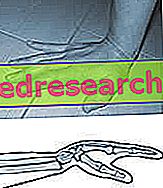THERAPEUTIC GROUP: Ophthalmology
IndicationsAction mechanismStudies and clinical effectiveness Usage and dosage instructionsWarnings Pregnancy and lactationInteractionsContraindicationsUndesirable effects
Indications Atropine
Atropine is used in the field of ophthalmology, in the form of eye drops, as cycloplegic mydriatic of the eyeball and its appendages.
Mechanism of action Atropine
Atropine is an anticholinergic drug, structurally belonging to the broad category of alkaloids, used in the ophthalmological field as cycloplegic mydriatic.
More precisely, this active ingredient, administered topically by eye drops, is able to bind to the muscarine acetyl choline receptors by exerting a striking anticholinergic effect which takes the form of paralysis of the sphincter muscle of the iris and of the ciliary muscle.
All this results in the evident mydriatic effect, ie in a dilation of the pupil, and in the cycloplegic effect, useful to block the visual accommodation reflexes, with a rapid onset timing, about 30 minutes and with a duration of action particularly long (days).
Fortunately, following application by eye drops, the systemic absorption of Atropine is scarce and of little relevance from the clinical point of view, thus limiting all the potential biological effects of this active ingredient.
Studies carried out and clinical efficacy
THE EFFECTS OF THE AROPINE ON THE DIOTTRIC PROPERTIES OF THE SCLERA
Ophthalmic Physiol Opt. 2012 Nov; 32 (6): 478-84. doi: 10.1111 / j.1475-1313.2012.00940.x. Epub 2012 Sep 17.
Spanish study conducted on experimental models that demonstrates how the use of Atropine based eye drops can determine histological changes of the sclera, such as to compromise the normal refractive capacity of the same.
THE INFLUENCE OF ATROPINE ON RETINAL FUNCTIONALITY
Doc Ophthalmol. 2013 Jun; 126 (3): 177-86. doi: 10.1007 / s10633-012-9372-8. Epub 2013 Jan 5.
Work that seeks to characterize the possible biological effects of collin anthropine on the eletroretinogramma of small myopic patients. The study shows no difference depending on the use of Atropine, thus highlighting the absence of potential influences.
ATROPINE: MAXIMUM DOSAGE WITHOUT CLINICAL EFFECTIVENESS
Optom Vis Sci. 2013 Sep 26. [Epub ahead of print]
Pharmacokinetic study that seeks to characterize the minimum dose capable of not producing significant clinical effects such as mydriasis or cycloplegia, identifying it in the concentration of 0.02%.
Method of use and dosage
Atropine for ophthalmic use is generally found in eye drops at 0.5% - 1% of active ingredient.
Always according to medical needs, Atropine is instilled in different dosages and times, directly in the conjunctival sac or in the back bulbar site.
Atropine warnings
The use of Atropine in eye drops is evidently justified by important medical needs, as happens for the various operative phases or following serious ocular traumas.
Generally it is appropriate to remember how the use of Atropine, in addition to compromising, limited to the duration of action of the drug, the visual capabilities of the patient, could unmask forms of glaucoma previously gone unnoticed.
The ingestion of Atropine based eye drops could lead to the onset of severe systemic adverse reactions, therefore it is recommended to keep the drug out of the reach of children.
PREGNANCY AND BREASTFEEDING
The use of Atropine based eye drops, during pregnancy and in the subsequent breastfeeding period should be limited to cases of inevitable necessity and always take place under the careful supervision of your doctor.
Interactions
Drug interactions worthy of clinical note are currently unknown.
Contraindications Atropine
The use of Atropine in eye drops is contraindicated in patients hypersensitive to the active ingredient or to structurally related drugs and in patients suffering from glaucoma, asthma and pyloric stenosis.
Undesirable effects - Side effects
Atropine eye drops therapy is generally safe and free of clinically relevant side effects.
However, although rarely the use of this drug could lead to the appearance of side effects such as: reduction of gastric and salivary secretion, reduction in the tone of intestinal and vesicular muscles, reducing nasal secretions and determining an increase in endocular pressure.
Note
Atropine in eye drops is a prescription drug subject to mandatory medical treatment.



